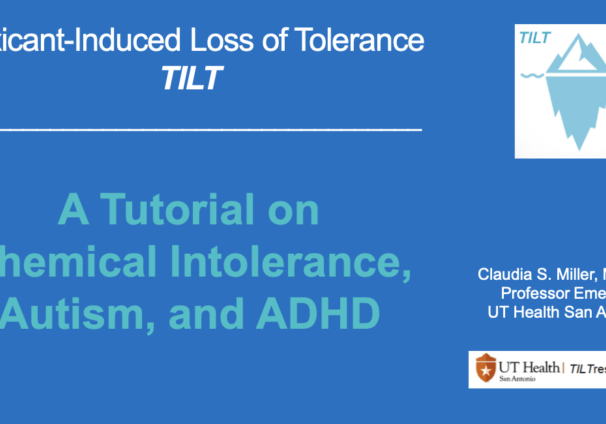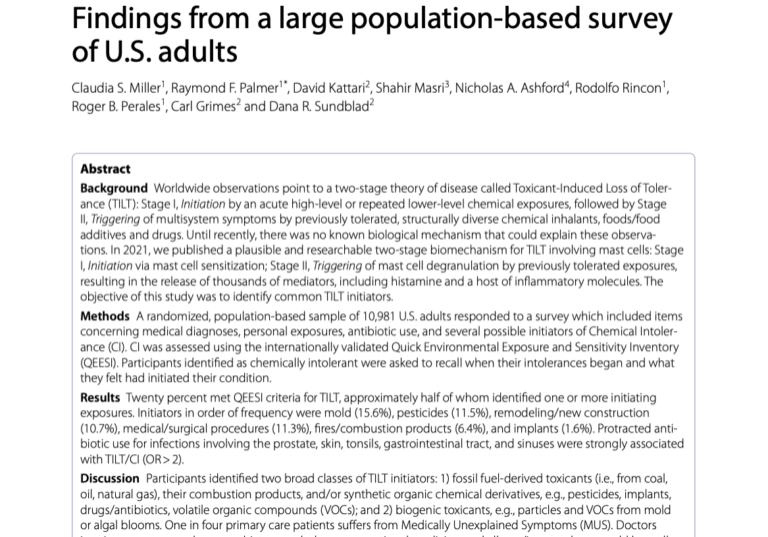Toxic-Induced Loss of Tolerance (TILT)
Our current understanding of what constitutes dangerous levels of toxic exposure is changing with advances in science, medicine, and technology.
The World Health Organization attributes one-quarter of the global “disease burden” (the cost of the disease in lives and health care), and one-third of the burden among children under age 5, to toxic chemicals in our environment. Understanding how chemicals affect our bodies can lead to avoidance of toxic exposures, proper diagnosis of the cause instead of “MUS” (medically unexplained symptoms), and early intervention with proper treatment and health practices.
This is especially true after oil-chemical disasters where early and accurate diagnosis of chemical exposure can lead to reducing long-term harm.
Latest Research
Causes, Symptoms of Chemical Intolerance and Ways to Reduce Everyday Chemical Exposures
A Tutorial created by Dr. Claudia S. Miller, MD shows the causes and symptoms of chemical intolerance and ways to reduce everyday chemical exposure.
Large Population-Based Study of U.S Adults Analyze What Initiates Chemical Intolerance
A large population-based study of U.S. adults finds chemical intolerance is initiated by fossil fuel-derived toxicants from oil and natural gas, synthetic organic chemical derivatives like pesticides, and biogenic toxicants from mold and algal blooms.
Study Shows Improved Indoor Air Quality Lessens Chemical Intolerance Symptoms
A 2022 study published by Cambridge University Press shows that improved indoor air quality can lessen the symptoms of Chemical Intolerance after exposure to chemical inhalants.
Mast cell activation may explain many cases of chemical intolerance (2021)
Explains how bodies respond to chemicals below levels thought “safe”
Toxicant-induced loss of tolerance for chemicals, foods, and drugs: assessing patterns of exposure behind a global phenomenon. (2021)
Chemical intolerances following 8 disasters – 9/11, Iraq War burning pits, BP Deepwater Horizon, and more
Environmental chemical assessment in clinical practice: Unveiling the elephant in the room. (2016)
Addresses human exposure to chemicals in our environment, chronic diseases and accurate clinical diagnosis and treatment.
What is Toxic Induced Loss of Tolerance?
Chemical intolerance is when a person can develop after short-term exposure to high levels of chemicals, including levels below those thought to be “safe”, or after daily exposures to low levels of chemicals.
Toxic Induced Loss of Tolerance (TILT) is a relatively new concept. It is defined as a two-stage disease process characterized by new-onset intolerances to certain chemicals, foods, and drugs following “initiation” by a major exposure event (or repeated low-level exposures).
Why is this a breakthrough?
Governments and organizations that must address chemical exposures either for worker protection or public health and consumer products, usually do so by establishing a “safe” limit for each chemical. However, historically these limits have not accounted for mixtures of chemicals, cancer-causing chemicals for which there is no safe exposure, and a branch of the immune system that reacts to even low-level exposures. As a result, people can be overexposed and under-protected to chemicals – and the health toll is mounting.
Long-term heath monitoring of 9/11 first responders, Gulf War vets, the BP Deepwater Horizon and other large oil spills have found early symptoms of exposure are linked with long-term illnesses. Large population biomonitoring studies of the general population have documented widespread chemical exposures from womb to tomb. The World Health Organization attributes one-quarter of the global “disease burden” (cost of the disease in lives and health care), and one-third of the burden among children under age 5, are due to toxic chemicals in our environment.
Why is this so important?
Many of these illnesses may be preventable by making conscious choices to rid or reduce toxic chemicals in both our environment and bodies.
Recent research has confirmed what was long suspected: Even low-level exposure to toxic chemicals can create chemical intolerances. Subsequent chemical exposures can outright kill people or leave individuals intolerant to many chemicals, including fragrances, the soap aisle in a grocery store, the “new” smell in furniture, oil-based paints, the tire area in big box stores, etc. It can also make people more at-risk when oil-chemical disasters or pandemics hit.
This is a significant finding, as in the last 100 years, chemicals in our air, water, soil, food, building materials, and household products have vastly increased, as have “medically unexplained syndromes” that are now being linked to the mix of thousands of chemicals in the environment.
How does a person become intolerant to common chemicals?
Chemical intolerance happens when mast cells act as first responders to toxic chemicals within our cells. Mast cells evolved as the first defenders in the immune systems of all vertebrates, including humans, some 500,000 million years ago. With repeated exposures to chemicals, mast cells can become more reactive to or intolerant of future exposures. Mast cells are paired directly with nerve cells and can transmit signals quickly throughout the body. The result is a “sudden” intolerance to smells or foods or drugs that were previously tolerated – and often medical confusion.
People who develop sudden intolerances need to be their own advocate.
Resources
Step 1: How does Chemical Intolerance Work?
- What initiates Chemical Intolerance?
- Roots of Chemical Intolerance
Step 2: Long-Term Health Effects
- Autism & ADHD
- TILT Tutorial
Step 3: Am I Chemically Intolerant?
- What does Chemical Intolerance Look Like?
- Take the Self Assessments
- Chemical Assessment for Clinicians
Step 4: Reduce Your Exposures
- Improving Air Quality
Do you believe you have been chemically exposed?
We have free resources available to the public.




